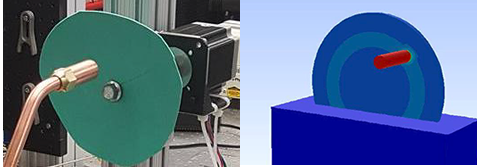Intelligent Power Systems
Annual PlanThermal Barrier Coatings for Reduction of Cooling Loads in Military Vehicles
Project Team
Government
Eric Gingrich, U.S. Army GVSC
Industry
Shawn Dolan, Henkel of America, Inc.
Student
Taewon Kim, Wayne State University
Project Summary

Total under-armor volume of a military combat vehicle is typically constrained by vehicle size and weight limitations. As much as 40% of this volume is devoted to the powertrain [1] that includes the thermal management system comprising ballistic intake grilles, fans, ductwork and radiators [2]. Reductions in cooling load are therefore sought to make greater under-armor volume available for mission-critical sub-systems or crew and to improve mobility and fuel efficiency by diminishing vehicle weight.
The energy balance of a diesel engine is roughly evenly distributed between the exhaust, coolant, and brake power. Efficiency gains therefore imply reductions in the sum of exhaust and coolant loads. By reducing heat transfer from engine in-cylinder surfaces, thermal barrier coatings (TBC) have long been examined through simulation [3-5], experiment [6-8], and thermodynamic analysis [9] as a means of increasing powertrain efficiencies and have been a key technology in the development of adiabatic or low heat rejection engines. Notably absent from the literature, however, are references to uniquely military applications of TBCs, where significant advantage may be gained by redistributing the cooling load to the exhaust and reducing the required armored volume area requirements of the thermal management system.
The overarching goal of this project is to develop an understanding of heat transfer through thermal barrier coatings of various thickness, material, and deposition method, for the purpose of reducing the cooling loads of engines for military vehicles. Outcomes will be supported by experimental measurements, and provide data for evaluating the relative merits of different coating technologies. The project will address the salient issue of durability through thermal shock tests, temperature profile and penetration depth measurements, and provide indication of potential cooling load reduction through the use of TBCs. The proposed work is one of the first efforts to evaluate TiO2 as a viable material for TBCs.
References:
- W. Bryzik and R. Kamo, “TACOM/Cummins Adiabatic Engine Program,” 1983.
- J. P. Chiou, “Engine Cooling System of Military Combat/Tactical Vehicles,” 1975.
- D. N. Assanis and E. Badillo, “Transient Heat Conduction in Low-Heat-Rejection Engine Combustion Chambers,” 1987.
- R. Kamo, D. N. Assanis, and W. Bryzik, “Thin Thermal Barrier Coatings for Engines,” 1989.
- V. W. Wong, W. Bauer, R. Kamo, W. Bryzik, and M. Reid, “Assessment of Thin Thermal Barrier Coatings for I.C. Engines,” 1995.
- C. H. Moore and J. L. Hoehne, “Combustion Chamber Insulation Effect on the Performance of a Low Heat Rejection Cummins V-903 Engine,” 1986.
- R. H. Thring, “Low Heat Rejection Engines,” 1986.
- W. R. Wade, P. H. Havstad, E. J. Ounsted, F. H. Trinker, and I. J. Garwin, “Fuel economy opportunities with an uncooled Dl diesel engine,” 1984.
- B. Johnson and C. Edwards, “Exploring the Pathway to High Efficiency IC Engines through Exergy Analysis of Heat Transfer Reduction,” SAE Int. J. Engines, vol. 6, pp. 150-166, 2013.

